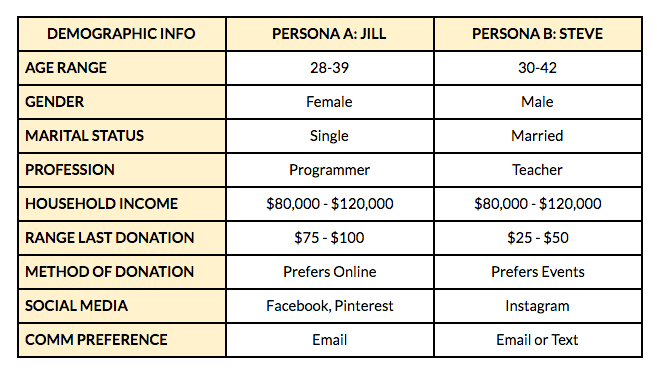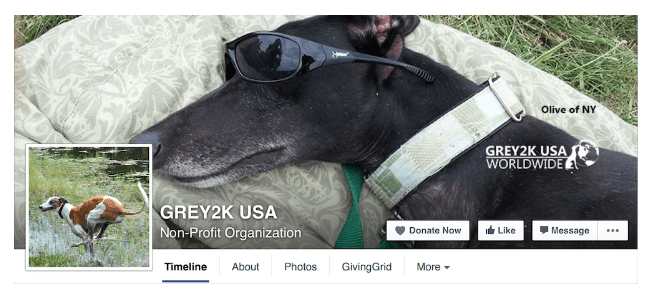The bulk of a fundraiser’s day isn’t spent planning fun events or wining and dining. In fact, we spend the majority of our time tracking down donors.
And, if we’re completely honest, it’s not exactly the most “exciting” part of the job. In fact, it’s a task many of us come to dread over time.
If you’re planted firmly in the “dread” group, you’re not alone. But how do you meet your fundraising requirements if you’re not actively (and frequently) seeking out your donors? It’s a good question with a definitive answer.
You can raise money while inspiring and engaging your donors simply by delighting them with effective communication.
“You can raise money while engaging your donors simply by delighting them with effective communication.“ tweet this
Giving your donors a truly meaningful, positive experience and not just the occasional obligatory update or thank you can make an enormous difference when it comes to donor retention. And if you can raise these recurring donation rates by making your donors feel special, the rest of your fundraising efforts are a little less stressful and your job is bound to be easier.
So, it’s time for honesty. Ask yourself: Am I really delighting my donors?
If not, don’t worry! Follow this surefire delighting strategy that focuses on the who, what, where, when, why and how of your donors.
By following these communication steps, you’ll inspire, activate, and rally your supporters to become lifelong friends of your cause.
Know Their Background: Who Are Your Donors?

Let’s start with the most basic question: who are your current donors?
You may believe that you know your donors well enough already. After all, you have their basic information and connect occasionally when it comes time to ask for a donation. But if you haven’t looked at the demographic breakdown of your current donor list in some time, it’s time to start pulling reports and digging deep into the data.
Data such as age, gender, profession, prior donations, events attended, and a host of other information will give you a better understanding of the types of people who support your mission.
Use all the data you gather to start building segmented lists or, better yet, a set of personas so each time you plan donor outreach, you will know how to get information across to each group.
How many personas should you have? It’s a good question with a complicated answer. It depends on your organization’s needs and the type of information available for each donor. The more information you have, the more specific you can get with each persona, and the better you can ultimately understand who you’re reaching.
Examples Of Personas

You can see from the two personas above that messaging and delivery will differ for each group.
Next Step: Make sure you understand as much about your donors as possible by compiling and using relevant donor data. Use personas as a targeted way to segment groups and cater certain communications.
Learn About Motivations: What Do Your Donors Want & Expect?

Now, it’s time to dig a little deeper past basic donor data. You now know who you donors are, but it’s impossible to pinpoint their motivations from demographics and peripheral data alone.
Take the time to survey donors to help you get a better understanding of their motivations and expectations. While you’re naturally going to reach out to donors who consistently give, remember to also survey those who don’t, as their responses can provide insight into how to reacquire them in the future.
Use an online site like SurveyMonkey to give supporters a way to anonymously provide feedback. Then, follow these survey best practices:
- Keep it short and simple
- Let donors know how much time it will take to complete the survey
- Allow space for written responses or additional feedback at the end of the survey
- Ensure you’re sending it from a known name such as the CEO or fundraising team member and not just a generic message from your organization
Make as many of the questions as possible multiple choice, leaving one or two for expanded freeform answers. Here are a few sample questions:
- What prompted you to donate to our organization?
- What kind of information do you want after you donate?
- How often would you like to receive updates on the organization?
- Have you ever considered setting up monthly donations?
- What can we do to exceed your donor expectations?
Don’t hesitate to resend the survey to those who didn’t respond during the first round 1-2 weeks later.
Make sure recipients know that this is strictly for feedback – you’re not asking for donations. If you contact donors asking for something other than a donation, it sends the message that you care about their opinions and that ultimately helps build a foundation of trust and goodwill.
Next Step: Survey your current donors following best practices.
Specify Your Avenues: Where Are Your Donors?

Now that you’re armed with information about your donors, surveyed them to get direct feedback, and segmented your lists/created personas, you’re ready to start planning targeted outreach.
Remember: the goal isn’t just to communicate, it’s to delight.
Ask yourself: Where are your donors’ communication hangouts?
No, you don’t have to stalk them at the local sports bar, gym, or restaurant, (although it’s not unheard of). Instead, determine the top three ways your donors like to communicate.
“Remember: the goal isn’t just to communicate, it’s to delight.“ tweet this
These may include:
- In-person
- Text
- Direct mail
- Social media platforms
- Other
- Phone
- Third-party newsletters (churches, professional organizations, social clubs)
If you look back at the two example personas above, you’ll see that both prefer email communication and both are active on social media but on different sites. It’s likely that the vast majority of your donors fall into two to three of the categories noted above.
From here, you can personalize your messaging, catering to your donor audiences where they are (which is also where they prefer to be).
What About That Social Media?
Let’s take a moment to address social media and its role in delighting donors.
There are organizations that nail social and some that just cannot seem to crack the code. For starters, don’t let social media intimidate you! Conquer it like you would any challenge— scope out the social media landscape and see what other organizations are doing.
If you want to delight donors, it’s not enough to just send updates via social media. It’s necessary to use every possible aspect and feature of the platforms you plan to use.
For inspiration, take a look at how Grey2K USA manages their Facebook page.

The first thing you notice is the choice of images. The cover photo shows a real rescued greyhound—and they identify the dog by name, “Olive of NY.” She’s chillin’ in her sunglasses. That’s one happy dog bound to help the organization’s online audience emotionally connect with the cause. Remember, a picture is worth a thousand words and can be effectively used to tell your nonprofit story. It’s the perfect inspiration!
This greyhound rescue organization knows their supporters want to see that they are actively improving the lives of former race dogs. Therefore, their posts are all about dog rescue, including updates on pending legislation. They have over 100,000 followers and their posts are shared and liked frequently because they’re relevant to their audience.
In terms of frequency, Grey2K USA posts something related to their cause at least once a day and oftentimes even several times a day.
They also provide fact nuggets: short, educational bits of information meant to increase awareness and build organic support for their cause. It’s information that is easy to recall and passed along either through social or in conversation.
Grey2K does social media right by following these best practices:
- Posting content relevant to their cause
- Including powerful images that describe their work
- Ensuring content is easily digestible
- Encouraging people to share, comment, or otherwise engage with posts
For more information on how to use social media in crowdfunding, read our Comprehensive Guide To Social Media For Crowdfunding.
No matter how you communicate with your donors, make sure that the message is on point and invites engagement of some sort, whether that is sharing, “Liking,” leaving a comment, etc.
Remember, communications don’t always need to be related to donating or getting involved. They can (and should) be about transferring information regarding your cause. At the end of the day, you’re pulling supporters to you and engaging them in a conversation around your mission. It’s this inspiration that eventually leads to activation (donations and other support!)
Action Item: Identify your donor base’s top two or three communication preferences and focus on those. Inform and engage where your donors are most likely to see and interact with your message.
Trial and Error: When Should You Communicate With Donors?

The timing and frequency of donor communication is a delicate dance.
Over-communicate, and you risk annoying your supporters—a far cry from delighting them. Under-communicate, and you won’t get the results you need. Along the same lines, we’ve seen many organizations operate under the premise that a sent message is a “seen” message. Unfortunately, this isn’t the case.
All in all, it’s best not to leave this to chance.
While every communication method has a best practice for when and how often to distribute messages, it’s best to figure out your own audience’s preferred timing through trial and error.
Review Your Data: Start by testing the waters. Consistently review information on email, social media, and text messages that shows how many people have opted out from receiving communications or who have stopped following you. If you notice large upticks in opt-out rates, decrease your frequency off the bat.
Along the same lines, keep track of open rates and when people engage with you. If more people read your message later in the day, then you know this is when to post social media updates and/or send email. If engagement is not where you’d like it to be, rethink your message and look at the time of day that you’re sending or posting messages.
Use A/B Testing: To get a solid grasp on your donor’s needs, consider A/B testing. If timing is a concern of yours, try sending the same email/message out to different audiences at two different times. The time slot with the best engagement rates is the one to go with moving forward.
Action Item: Regardless of how you communicate to your donors, make sure that you’re optimizing the time and frequency of your messages. Delighting donors isn’t just about the message, it’s making sure they have the opportunity to engage with the message.
Dig Deep: Why Do Your Donors Support Your Mission?

This is where you really get to target your messaging – and if you’ve done your homework and analyzed your survey results, it’s also where you get to have some fun!
Obviously, the people who support your mission are drawn to the work that you do, but did they donate solely based on that information or because of your fundraising strategies?
The closer you can get to the “why” of the give, the better your communication and fundraising strategies will be.
For instance, let’s say that 25% of those surveyed said that the reason they donated to your organization was because of a compelling story they read about someone whose life was changed because of your organization.
What do you think you might want to do with that information? Share more compelling stories, of course! From there, you can form a comprehensive plan to focus on this “why” by:
- Highlighting one client story per month on your website.
- Posting the story to social media.
- Including a success story in your quarterly newsletter.
- Soliciting stories directly from people who benefited from your organization’s work on a regular basis
Let’s venture to guess that another segment of your donors said that were activated to give primarily because they were drawn to your mission and feel that they can make a real difference by supporting it.
Therefore, every chance you get to reach out to this group should include specifics about their donation’s return on investment. A simple “Your last gift provided a month’s worth of meals for someone battling cancer” effectively connects your mission to their donation.
Naturally, donor motivations vary, but they’re most likely to fit into one of these categories according to the 2016 U.S. Trust Study:
- The donor believes in your mission and work
- The donor believes they can make a difference by giving to your cause
- Giving provides personal satisfaction
- The donor gives because they did so before
- Giving helps support the community
- Giving is tied into a donor’s religion/faith
Action Item: Target your messages by segmenting them by the reasons why a donor supports your mission. Be creative in your outreach to capitalize on the emotional stories that your organization naturally produces.
Final Action Steps: How To Delight Everyday

Are you already a pro at communicating with your donors? Here are a few other ways to delight them.
Keep Staff “In The Know”: Make sure your staff know the names of your frequent or top donors by posting a donor board in your office.
Highlight Rockstar Donors: Add a donor spotlight to your website. Each month, give a brief story about a specific donor and why they support your mission. Don’t choose donors based on their gifts, but based on their passion for your cause.
Show Appreciation: Send thank you notes or make phone calls on occasion to thank supporters for their gifts of time and money. You can also host a donor appreciation event. If costs are a concern, create a virtual open house on Facebook or Twitter and invite donors to see your projects and ask questions.
Ask Your Clients For Help: If your organization is all about kids, put up a thank you table with cards and pens for one week and invite the children to write notes to donors. Include the cards in an upcoming campaign. Along the same lines, if your nonprofit is focused on animal rescue, ask families who have adopted pets to submit video messages to supporters of your organization.
Delighting donors is about making each one feel as though they are vital to your cause – and indeed they are. But it’s impossible to create this bond without understanding them and communicating appropriately.
“Delighting donors is about making each one feel as though they are vital to your cause.“ tweet this
If you understand the motivation behind their support, their communication preferences, and the best times to reach out to them, your outreach will be more effective, and your donors will continue to be inspired and activated—ready to give of time, money, and general support when the time comes.
Effective communication is good for the donor, it’s good for your organization, and it’s great for the people and places your mission supports.
Everyone’s delighted when your donor is!
Read our article 5 Ideas That Put The Fun In Fundraising for even more ways to delight donors.
Editor's Picks
Ultimate Guide To Peer-to-Peer Fundraising
Customer Story: Spur Local Raises Over $1M With Their Give Local Campaign
Fundraising Strategies for Nonprofits: Craft the Best Approach for Your Organization
Create a Killer Fundraising Plan - Best Practices, Strategies, & Downloadable Template



